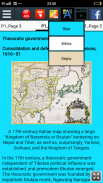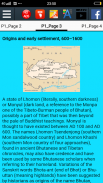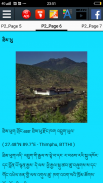










History of Bhutan

History of Bhutan介绍
Bhutan's early history is steeped in mythology and remains obscure. Some of the structures provide evidence that Bhutan existed as early as 2000 BC. According to a legend it was ruled or controlled by a Cooch-Behar king, Sangaldip, around the 7th century BC,[1] but not much is known prior to the introduction of Tibetan Buddhism in the 9th century, when turmoil in Tibet forced many monks to flee to Bhutan. In the 12th century, the Drukpa Kagyupa school was established and remains the dominant form of Buddhism in Bhutan today. The country's political history is intimately tied to its religious history and relations among the various monastic schools and monasteries.[2]
Bhutan is one of only a few countries which have been independent throughout their history, never conquered, occupied, or governed by an outside power (notwithstanding occasional nominal tributary status). Although there has been speculation that it was under the Kamarupa Kingdom or the Tibetan Empire in the 7th to 9th centuries, firm evidence is lacking. From the time historical records are clear, Bhutan has continuously and successfully defended its sovereignty.[3]
The consolidation of Bhutan occurred in 1616 when Ngawanag Namgyal, a lama from western Tibet known as the Zhabdrung Rinpoche, defeated three Tibetan invasions, subjugated rival religious schools, codified the Tsa Yig, an intricate and comprehensive system of law, and established himself as ruler over a system of ecclesiastical and civil administrators. After his death, infighting and civil war eroded the power of the Zhabdrung for the next 200 years. In 1885 Ugyen Wangchuck was able to consolidate power, and began cultivating closer ties with the British in the subcontinant.[2]
In 1907, Ugyen Wangchuck was elected as the hereditary ruler of Bhutan, crowned on December 17, 1907, and installed as the head of state, the Druk Gyalpo (Dragon King). In 1910, King Ugyen and the British signed the Treaty of Punakha which provided that British India would not interfere in the internal affairs of Bhutan if the country accepted external advice in its external relations. When Ugyen Wangchuck died in 1926, his son Jigme Wangchuck became ruler, and when India gained independence in 1947, the new Indian Government recognized Bhutan as an independent country. In 1949 India and Bhutan signed the Treaty of Peace and Friendship, which provided that India would not interfere in Bhutan's internal affairs, but would guide its foreign policy. Succeeded in 1952 by his son Jigme Dorji Wangchuck, Bhutan began to slowly emerge from its isolation and began a program of planned development. The National Assembly of Bhutan, the Royal Bhutanese Army, and the Royal Court of Justice were established, along with a new code of law.[2] Bhutan became a member of the United Nations in 1971.
In 1972, Jigme Singye Wangchuck ascended the throne at age 16.[4] He emphasized modern education, decentralization of governance, the development of hydroelectricity and tourism and improvements in rural developments. He was perhaps best known internationally for his overarching development philosophy of "gross national happiness." It recognizes that there are many dimensions to development and that economic goals alone are not sufficient. Satisfied with Bhutan's transitioning democratization process, he abdicated in December 2006 rather than wait until the promulgation of the new constitution in 2008. His son, Jigme Khesar Namgyel Wangchuck, became King upon his abdication.[2]
不丹的早期历史是神话悠久,仍不清楚。一些结构提供了证据,不丹,早在公元前2000年的存在。根据它是由库奇 - 比哈尔王,Sangaldip,围绕公元前7世纪统治或控制的传说,[1]但在此之前于9世纪引进藏传佛教,当风暴在西藏迫使许多不被知道僧侣逃往不丹。在12世纪,竹巴噶举派学校成立,并保持在不丹是佛教的主要形式。该国的政治历史是紧密联系在一起的宗教历史和各个寺院学校和寺院之间的关系。[2]
不丹是只有少数几个国家已经独立在其整个历史中的一个,从来没有征服,占领或统治由外部力量(尽管有时也标称支流状态)。虽然一直猜测,这是根据迦摩缕波王国或吐蕃在7日至9世纪,公司证据不足。从时间史料记载很清楚,不丹不断成功的捍卫了国家主权。[3]
不丹的合并发生在1616年的时候Ngawanag朗杰,西藏西部喇嘛被称为Zhabdrung仁波切,分兵三周西藏的入侵,征服了对手宗教学校,编纂该协议YIG,法律的复杂和全面的系统,并确立了自己的统治者在教会和民政人员的系统。他去世后,内讧和内战侵蚀Zhabdrung的力量在未来200年。 1885年乌金·旺楚克才得以巩固权力,并开始培养与英国在subcontinant更紧密的关系。[2]
1907年,乌金·旺楚克当选为不丹的世袭的统治者,荣登1907年12月17日,并安装为国家元首,在天龙嘉波(龙王)。 1910年,国王乌金和英国签署,其中规定英属印度不会在不丹内政干涉,如果该国接受其对外关系外部建议普那卡条约。当乌金·旺楚克于1926年去世,他的儿子吉格梅·旺楚克成为统治者,而当印度在1947年获得独立,印度新政府承认不丹作为一个独立的国家。 1949年印度和不丹签订和平友好条约,其中规定,印度将不会在不丹的内政,但将指导其外交政策。由他的儿子吉格梅·多吉·旺楚克于1952年成功,不丹开始慢慢从隔离出来,并开始规划发展方案。不丹国民议会,皇家不丹军方和司法皇家法院建立,法律的一个新的代码一起。[2]不丹成为联合国的一员于1971年。
在1972年,吉格梅·辛格·楚克即位在16岁时[4]他强调现代教育,管理的权力下放,水电,旅游和改进农村发展发展。他也许是最国际知名的为他的总的发展理念,以“全民幸福”。它认识到,有许多方面的发展和经济目标单单是不够的。满意不丹的过渡民主化进程,他在2006年12月宣布退位,而不是等到2008年新宪法,他的儿子吉格梅·凯萨尔·纳姆耶尔·旺楚克,成为国王后,他的退位的颁布。[2]
























